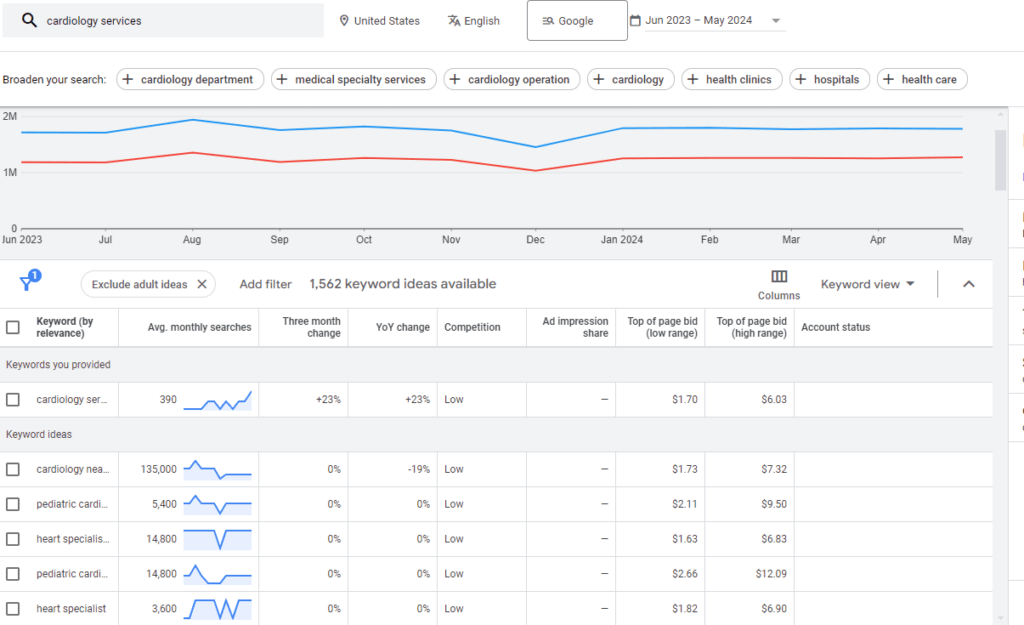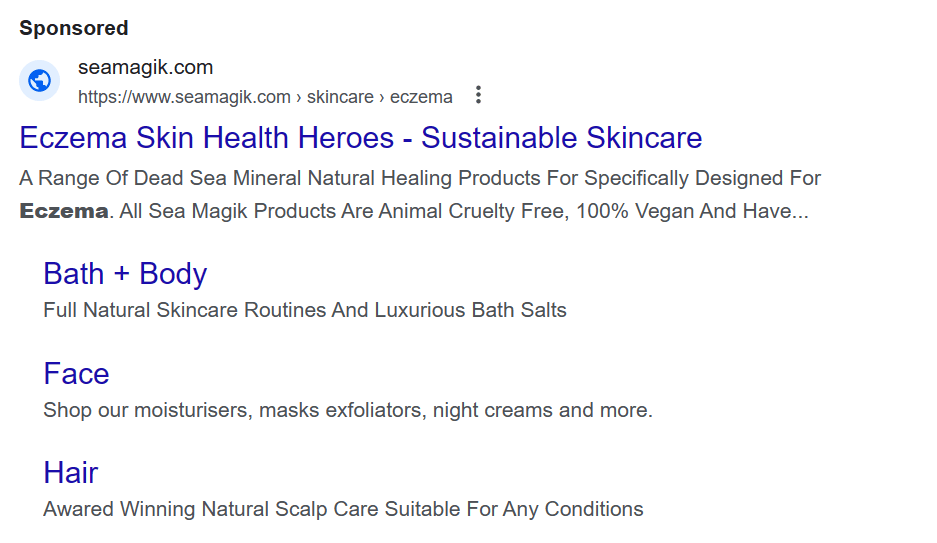Through our experience working with small to medium-sized healthcare institutions, we’ve come across some unique challenges these businesses face.
It’s all about connecting with potential patients, but regulations often stop healthcare businesses from even trying. For those who try, there is a problem of competing with large corporations that dominate the industry.
One powerful strategy that has emerged to tackle these challenges is PPC for healthcare.
With PPC, your healthcare practice can appear on top of search results exactly when potential patients are looking for your services. What do you get with PPC for the healthcare industry?
- You drive traffic to your website.
- You reach a qualified audience at the right time.
- You build trust with patients and encourage them to buy your services.
But how much will this cost and which strategies you need to achieve these results?
That’s why we’re here! We’ll talk about the ins and outs of PPC in healthcare, how you can use it to engage with patients, share results you can expect from campaigns, and give you a free calculator to see your potential profits right away.
What Is PPC in Healthcare?
PPC advertising is a digital marketing strategy for attracting new patients where you pay a fee ONLY when potential patients click on your ad. This means you’ll drive targeted traffic and attract qualified leads. It’s a great strategy to get new clients while you wait for SEO for medical practices to start producing results.
PPC in healthcare gives you the ability to serve ads on search engines and other websites. These ads are “triggered” only by specific keywords you set, meaning you won’t get leads for unrelated services.
For instance, if someone searches for “best cardiologist near me,” your ad can show up right at the top of their search results, capturing their attention immediately.
One of the biggest advantages of PPC is its precision targeting.
You can create ads that reach specific demographics geographic areas, and even target by the time of day. This means that people who are most likely to need your services are going to see your ads, get familiar with your services and you’ll get better engagement and higher ROI.
PPC campaigns are also highly measurable. You can track every click, see which ads are performing best, and adjust your strategy accordingly.
Paying a high price per click? No worries, you can continually refine your campaigns and make sure you get the most out of your advertising budget.
Free PPC Profit Calculator for the Healthcare Industry
We bet you’re wondering how much you need to pay per click. Maybe you even think it won’t be profitable. That’s why we’ve developed a free PPC profit calculator for the healthcare industry.
It’s not your usual calculator but the refined tool that uses CPC and CVR metrics across the healthcare industry.
How does it work?
- Enter the average revenue every customer brings to your business.
- The calculator will automatically subtract the marketing costs from the revenue to give you a profit per customer.
PPC for Healthcare: Real-Life Results
Let’s take a look at how PPC can deliver outstanding results in the healthcare industry through a real-life example and some worth knowing PPC case studies.
Icy Bear achieved remarkable success by partnering with NUOPTIMA, a PPC agency that gets qualified leads, to run their Facebook Ads. When we say remarkable, we mean a stunning 9x ROAS and remarketing at 17x ROAS.

But how did we do it?
- We mapped out the demographics, interests, and behaviours of their ideal customers.
- Once we nailed the audience, we used a lookalike audience based on their website visitors.
- We run retargeting ads to people who’ve visited their website.
- We made their carousel ads stand out with high-quality images and videos showcasing the benefits of their products.
- We created high-performing ad copy and highlighted the unique selling points of each product.
- To spice it up and bring the CPA down, we added influencer content to the mix.
- We chose appropriate ad objectives, including lead generation and sales.
- By monitoring the performance of each campaign, we managed to refine the ads to perform even better for the same budget.
All these fine-tunings paid off. Icy Bear sales from lookalike ads were £14.4k and £6.3 from retargeting.
Still not sure how you can get similar or better results? Let’s walk you through healthcare PPC strategies that will bring your CPA (cost per acquisition) down and give you the kind of ROAS you’ve been looking for.
What to Pay Attention to Regarding PPC for the Healthcare Industry?
As we’ve mentioned, it’s not the same to run PPC ads for healthcare as it is for other unregulated industries. What do you need to pay attention to if you don’t want your ads to get rejected by Google, Meta and other platforms?
- Make sure your ads comply with laws like HIPAA in the US, and Google’s healthcare and medicines policy [2]. Misleading claims, unverified treatments, or sensitive health information can lead to penalties or ad disapproval.
- Precision is crucial. Use demographic targeting to reach specific age groups, genders, and geographic locations.
- Your ad copy must be clear, professional, and compliant. Highlight the benefits of your services and include a strong call to action. Avoid sensational language or guarantees that can’t be backed up.
- Keep track of negative keywords as they prevent your ads from showing for irrelevant searches, saving your budget and improving ad relevance. For example, a general physician might exclude terms related to dental care.
- Monitor your campaigns and take action when something’s off. Metrics like click-through rates (CTR), conversion rates, and cost per acquisition (CPA) will guide you in making necessary adjustments to optimize results.
If you’re worried whether Google and other advertising platforms will reject your ads and ban your advertising account, make sure to avoid these:
- Prohibited content
Avoid promoting unapproved pharmaceuticals, misleading claims, or sensitive health information. Ensure all claims are substantiated and comply with Google’s healthcare and medicines policy. For example, avoind content like:
- “100% guaranteed weight loss”
- “Cheap prescription drugs”
- Misleading claims
Be honest and clear in your ad copy. Promising guaranteed results and sensational language are a big NO. For example, you must avoid copies with words like “Miracle cure”.
- Inadequate disclaimers
Include necessary disclaimers and ensure your landing page provides clear, accurate information about your services.
- “This information is not a substitute for professional medical advice.”
- Sensitive keywords
Use negative keywords to exclude irrelevant or prohibited terms, ensuring your ads appear only for appropriate searches.
- Sensational: “Cure your diabetes instantly with our treatment!”
- Right: “Manage your diabetes effectively with our comprehensive care plans.”
PPC for Healthcare Industry: Strategies to Boost Your Patient Engagement
Choosing the right keywords, creating strong and targeted ad copy with carefully placed CTAs on landing pages and optimizing your campaigns with ad groups are just one of the few strategies we’ll explain to guide you toward achieving better results and a higher return on investment.
Setting the Right Budget
From a couple of cents to a few hundred dollars, CPC varies greatly. The factor that influences it most is definitely competition. But with a few tweaks to your keywords, you can make healthcare PPC work even if your monthly advertising budget isn’t in the tens of thousands of dollars.
But how do you set the right budget for optimal results?
- Goals
Start by identifying what you want to achieve with your PPC campaigns. Do you want to increase patient appointments, promote a specific service or boost brand awareness?
- Analyze competitors
Research what your competitors are spending on PPC. Tools like SEMrush or SpyFu can provide insights into their ad budgets and strategies. This information can help you set a competitive budget.
- Calculate cost-per-click
Understand the average CPC for your targeted keywords. Healthcare-related keywords can be expensive, so knowing the CPC helps you estimate the cost of driving traffic to your site. Google Keyword Planner is a tool you can use for free to see the average CPC for every keyword.
- Budget estimate
Multiply the average CPC by the estimated number of clicks you want to achieve each month. This will give you a rough estimate of your monthly PPC budget.
- Other expenses
Consider additional costs such as landing page creation, ad copywriting, and ongoing management fees.
- Track performance
Start with a flexible budget and monitor your campaign performance closely. Google Analytics, Google Ad Manager, and Bing Ads Intelligence help you track and optimize your performance. Based on the results, adjust your budget to optimize performance and achieve your goals.
Ad Copy & Landing Pages
Creating compelling ad copy is an art that requires both creativity and precision, especially in the healthcare industry.
Your ad copy needs to speak directly to patients’ needs, offering a clear, trustworthy solution.
Start by focusing on the benefits your healthcare service provides. For instance, if you’re promoting a new treatment for chronic pain, your ad copy should emphasize how this treatment can improve quality of life and provide long-term relief. Instead of simply stating the features, paint a picture of the positive outcomes patients can expect.
Use phrases like “Manage your pain effectively with our treatment” or “Find relief and regain your daily activities.”
Your ad copy also needs to have a strong CTA (call-to-action) if you want to convert visitors into customers.
Encourage potential patients to take the next step, whether it’s scheduling an appointment, calling your office, or visiting your website for more information.
For example, effective call-to-actions can be “Schedule your consultation today” or “Discover how we can help you.”
When it comes to other aspects of your landing page, they should all reinforce the message of your ad copy and offer a great user experience.
Don’t make it too complex.
It’s enough to make it clear, easy to navigate, and focused on conversion. Include testimonials from satisfied patients, detailed information about the treatments, and a straightforward contact form.
As you know, visuals can make or break your landing page. You want conversions?
Well, high-quality images and videos that highlight your facilities, staff, and patient success stories build trust and make your landing page more engaging.
Consistency between your ad copy and landing page is key. If your ad promises a solution to chronic pain, the landing page should immediately address this issue and provide more in-depth information. Any discrepancy can lead to mistrust and lost opportunities.
Keywords & Negative Keywords for Healthcare PPC
Choosing the wrong keywords for your PPC campaign can drain your budget and bring unqualified leads to your doorstep.
It’s not just about reaching a broad audience but reaching the right audience–those who are actively searching for the healthcare services you provide.
Tools like Google Keyword Planner, and SEMrush can help you identify high-volume, relevant keywords. For instance, if you’re a cardiologist, you might focus on terms like “cardiology services,” “heart specialist near me,” “best cardiologist in [city]” or “cardiologist appointment.” These keywords reflect the searches your potential patients are making.

Equally important are negative keywords.
These are terms for which you don’t want your ads to appear, helping you avoid irrelevant traffic. For example, a pediatric clinic might exclude keywords like “adult cardiology” or “geriatric healthcare.”
But is that everything?
No, because intent is also important.
Keywords indicating high intent, such as “book cardiologist appointment” or “urgent care near me,” often result in higher conversion rates.
Once you hit publish on those PPC campaigns, don’t forget to monitor which keywords drive the most traffic and conversions. Ongoing optimization means you’ll never run out of qualified leads.
Create Ad Groups
Speaking of optimization, properly setting ad groups is where most healthcare businesses fail.
This is your unique opportunity to reap the benefits of PPC campaign optimization and gain an edge over your competitors. But what’s the right way to do it?
- Segment ad groups by service
Start by creating ad groups based on the specific services you offer. For example, a general healthcare provider might have ad groups for cardiology, dermatology, pediatrics, and so on. This helps you tailor your ads to the unique needs of each patient group.
- Get specific with keywords
Within each ad group, include tightly related keywords that match the search intent of potential patients. For a cardiology ad group, keywords might include “heart specialist,” “cardiology appointment,” and “heart health checkup.”
- Create highly targeted ads
Develop ad copy that directly addresses the needs and concerns of each group. For the cardiology ad group, ads might emphasize expert care, advanced diagnostic tools, and patient success stories related to heart health.
- Align landing pages with intent
Make sure that each group directs users to a relevant landing page. The landing page should provide detailed information about the service, include testimonials, and have clear calls to action such as “Book an Appointment” or “Learn More About Our Cardiology Services.”
- Let the data guide you
Look at metrics like click-through rates, conversion rates, and cost per conversion. Use this data to optimize your keywords, ad copy, and landing pages for better results.
PPC Targeting for Healthcare
In the healthcare industry, reaching the right audience at the right time can make a significant difference in patient engagement and conversion rates.
- Demographics
Focus on specific demographics such as age, gender, and income level. For instance, an OB-GYN practice might target women aged 18-45, while a cardiology clinic might focus on older adults. To optimize your efforts, it’s important to understand what are the 3 enrollment periods for Medicare, as these timeframes significantly impact patient engagement.
- Location
Narrow down your audience to specific geographic locations. If your practice is in a particular city or region, target users in that area to ensure your ads are reaching potential patients who can realistically visit your practice. Use radius targeting to show your ads to people within a certain distance from your location.
- Behavior
Utilize data on user behavior to reach individuals who have shown interest in healthcare services similar to yours. This can include users who have visited related websites, searched for related terms, or engaged with similar content.
- Device
Consider targeting ads based on the devices people use. This requires a little bit of A/B testing, but usually, mobile targeting works great as many patients search for healthcare services on their smartphones. Just make sure your ads and landing pages are mobile-friendly to capture this audience effectively.
- Time of the day
Analyze when your target audience is most active and adjust your ad schedules accordingly. For example, you might find that patients are more likely to search for healthcare services during the evening or on weekends.
- Retargeting
Implement retargeting strategies to re-engage users who have previously visited your website but did not convert. Retargeting ads can remind them of your services and encourage them to return and complete an action, such as booking an appointment.
Retargeting PPC Campaigns
If you’re wondering how to win clients with PPC, retargeting is a powerful strategy for converting potential patients who have already shown interest in your healthcare services.
Website visitors you retarget are 70% more likely to come back to your website and book an appointment. [1]
Imagine a potential patient visits your website, browses your services, but leaves without making an appointment. Retargeting allows you to remind this user of your services through targeted ads as they browse other websites or use social media.
To start, set up retargeting tags (Facebook Pixel or Google Tag Manager) on your website. Platforms like Google Ads and Facebook Ads provide these tags, which track visitors and enable you to display ads to them later.
It’s important to craft these ads to address any barriers that might have prevented conversion initially.
Remember, these are people who’re interested, but they haven’t bought anything from you yet.
To help them make the buying decision, you can offer a free consultation, highlight patient testimonials, or provide detailed information about your services.
But don’t forget to pay attention to segmentation when running retargeting ads.
Group your audience based on their behavior on your site–such as those who viewed specific services, spent a certain amount of time on the site, or abandoned a booking form. Customize your ads to these segments to address their specific interests and needs.
Frequency capping is another important aspect.
You want to remind potential patients without overwhelming them. Limit how often your retargeting ads are shown to the same user to avoid ad fatigue and ensure a positive brand experience.
The Best Healthcare PPC Examples

This PPC ad is a great example of healthcare advertising.
The ad targets specific keywords “eczema” and “sustainable skincare,” appealing to users searching for natural eczema treatments.
The headline “Eczema Skin Health Heroes” grabs attention, and the ad highlights unique selling points, such as being cruelty-free and vegan.
The structured sitelinks to “Bath + Body,” “Face,” and “Hair” provide easy navigation to different product categories, enhancing user experience and engagement.

This ad targets the keyword “physiotherapy” and focuses on a specific location, “Bristol,” which helps attract local patients.
The headline “Physiotherapy Clinic Bristol – Book Your Appointment Now” is direct and action-oriented.
The ad highlights the clinic’s advanced diagnostic technology and expertise, appealing to users looking for top-quality physiotherapy services.
The clear call to action, “Book Your Appointment Now,” encourages immediate user engagement and conversion.

This ad effectively uses the keyword “nutritionist” and targets women’s health, appealing to users seeking personalized nutritional advice.
The headline “London Nutritionist – Women’s Health Nutritionist” clearly states the service and location, making it relevant and specific.
The ad copy emphasizes personalized nutrition and unlimited 1-1 support, which builds trust and encourages potential clients to click for more information.
Conclusion
You’ve crafted ads that speak directly to patients’ needs, showcasing how your services can make a real difference.
You’ve set a precise budget, meaning every dollar you spend on PPC attracts those actively seeking your help.
Your keywords are spot on, drawing in the right audience, while negative keywords filter out irrelevant traffic. Ad groups organize your campaigns, serving relevant messages that resonate.
When potential patients leave your site, retargeting ads gently remind them of the benefits you offer, encouraging them to return and take action.
Through it all, you’ve stayed compliant with Google’s regulations, your ads are trustworthy, and your landing pages are transparent.
Ready to experience the impact of profitable PPC for the healthcare industry?
By working with Nuoptima, you’ll get similar or even better results than our clients from PPC case studies, meaning your ROAS will be enough to make your campaigns profitable. As a specialized PPC agency with deep knowledge of the healthcare industry, we make sure you get lower cost per acquisition to increase your profits.
Our strategies focus strongly on profitability, as you already saw from Icy Bear case study. But what does this mean for you?
Our healthcare PPC services will maximize your ROI and grow your patient base. All that’s separating you from these results is one quick and free strategic meeting.
So book a call, and don’t let the results wait!


